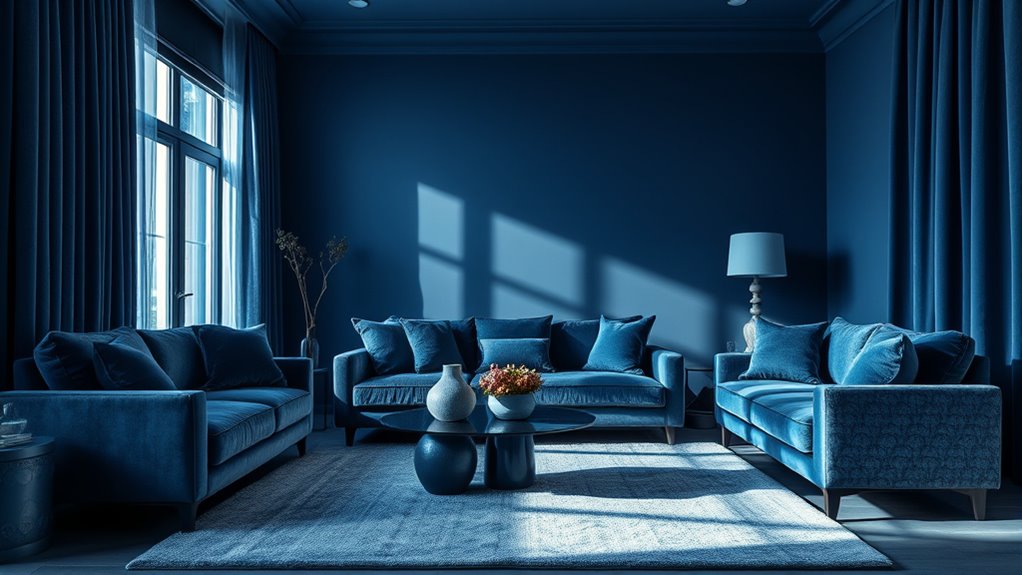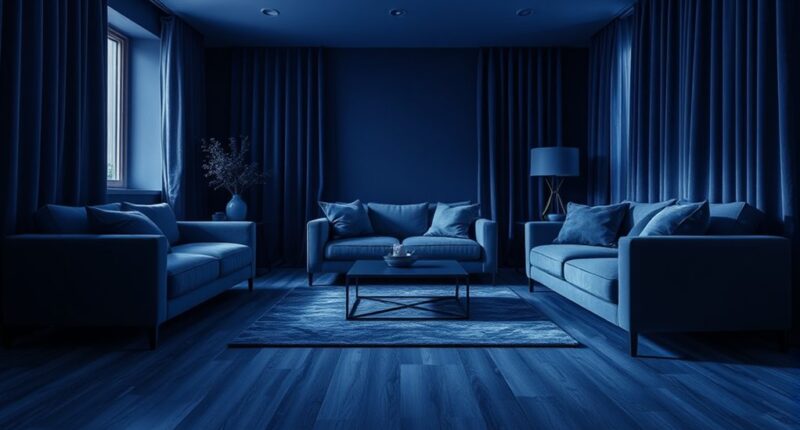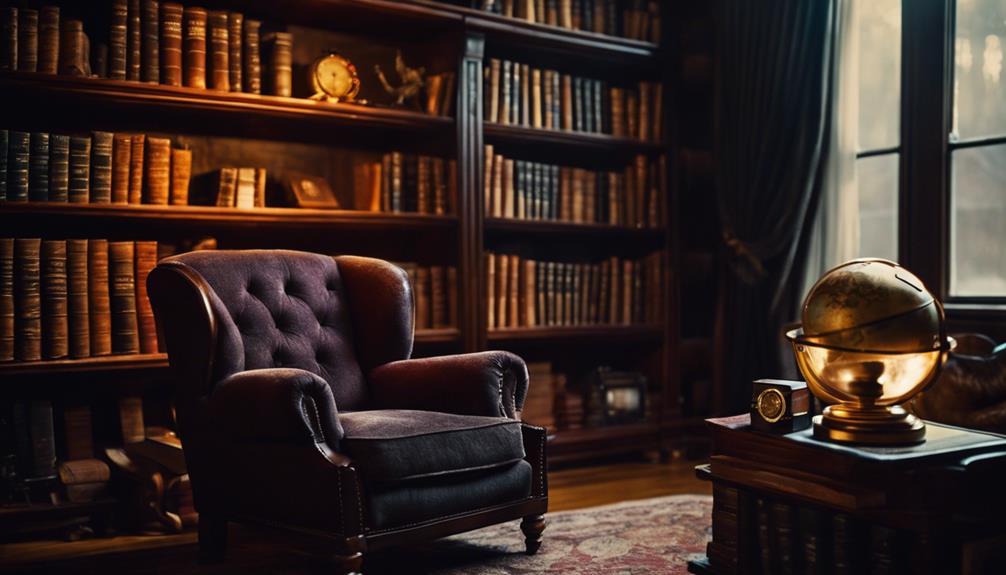A monochromatic decor style uses variations of a single color to create a cohesive, sophisticated look that makes a strong visual impact. You can achieve this by selecting a base hue that reflects the mood you want and adding shades, tints, and tones for depth. Incorporate different textures and finishes to add interest, and use lighting to highlight these details. Thoughtful accessories will complete the look, helping you craft a balanced, stylish space that speaks volumes with simplicity—exploring these techniques further reveals even more exciting possibilities.
Key Takeaways
- Select a dominant color to set the mood and create a cohesive look throughout the space.
- Incorporate various shades, tints, and tones of the same hue for depth and visual interest.
- Use different textures and materials to add dimension without introducing additional colors.
- Optimize lighting to highlight subtle shade variations and enhance texture contrasts.
- Add accessories like artwork and textiles in tonal differences to break uniformity and create visual movement.

Have you ever considered how a monochromatic decor scheme can transform your space? It’s a bold approach that uses variations of a single color to create a cohesive, sophisticated environment. While it may seem simple, mastering this style requires understanding color psychology and following some effective decorating tips. When you choose a dominant hue, you’re not just selecting a color—you’re setting a mood. For instance, blue often evokes calm and serenity, while red can energize a room. Knowing the emotional impact of colors helps you craft a space that aligns with your desired atmosphere. This is where color psychology becomes your best friend; it guides your choices and guarantees your decor resonates with your intentions.
Decorating tips for monochromatic decor focus on balance and texture. Start by selecting a base color that reflects the mood you want to establish. Once you have that, incorporate different shades, tints, and tones of the same hue to add depth and interest. For example, if you opt for green, mix emerald, sage, and mint to create visual layers. Don’t be afraid to play with textures as well—smooth fabrics, rough woods, glossy surfaces, and matte finishes all bring variety without breaking the monochromatic theme. This contrast enriches the space, making it more engaging without introducing additional colors. It’s also helpful to consider interior design principles to ensure your monochromatic scheme feels balanced and harmonious.
Balance texture and shades within your chosen color for a rich, engaging monochromatic space.
Lighting is another vital element. Proper lighting can enhance the variations within your chosen palette, emphasizing the subtle differences between shades. Use a combination of natural and artificial lights to highlight textures and create shadows that add dimension. Keep in mind that monochromatic doesn’t mean boring; it’s about sophistication and intentionality. To prevent your space from feeling flat, incorporate different materials and finishes that reflect or absorb light differently. This contrast creates a lively, dynamic environment that still maintains a unified look.
In addition, accessorizing thoughtfully can elevate your monochromatic scheme. Use artwork, pillows, rugs, or decorative objects that have patterns or slight variations in tone. These accents break up the uniformity just enough to keep the eye moving and prevent monotony. When you embrace the principles of color psychology and follow decorating tips that focus on texture, lighting, and accessories, you’ll find your monochromatic space feels intentional, calming, and stylish. It’s a powerful way to craft a room that feels both harmonious and visually compelling—proof that sometimes, less truly is more.
Frequently Asked Questions
How Can I Add Variety to Monochromatic Decor?
To add variety to monochromatic decor, focus on texture variety and pattern mixing. Incorporate different textures like velvet, wood, or metal to create visual interest. Mix patterns such as stripes, florals, or geometric designs within the same color palette to keep the space lively. You can also play with different finishes and materials, ensuring each piece complements the overall color while providing contrast through texture and pattern.
Which Colors Work Best for Monochromatic Schemes?
Sure, because who doesn’t want a room that screams “I couldn’t decide,” right? Bright blues, soothing greens, or warm terracotta work best for monochromatic schemes, depending on your mood. Use color psychology to pick hues that evoke calm or energy, then add complementary accents for contrast. This way, your space stays harmonious but engaging, proving that even a single color can pack a punch with the right choices.
How Do I Avoid a Dull Look With One Color?
To avoid a dull look with one color, you should incorporate color contrast and texture layering. Use varying shades of the same hue to add depth, and mix different textures like matte, gloss, and fabric to create visual interest. Adding accent pieces in contrasting tones can also break up monotony. These techniques keep your monochromatic scheme lively, engaging, and dynamic without losing its cohesive, elegant appeal.
What Lighting Options Enhance Monochromatic Interiors?
You can enhance monochromatic interiors with strategic lighting choices. Use fixtures in different styles to add visual interest and avoid flatness. Opt for warm or cool color temperatures depending on your mood, as warm light creates coziness while cool light offers a modern feel. Incorporate layered lighting, such as spotlights or wall sconces, to highlight textures and depth, ensuring your single-color palette remains dynamic and engaging.
Can Monochromatic Decor Suit Small Spaces Effectively?
Yes, monochromatic decor works well in small spaces because it enhances the sense of unity and space. You can use color psychology to choose calming or energizing shades that suit your mood. Incorporate texture layering with different fabrics and finishes to add depth and interest without cluttering. This approach makes your small space feel more expansive and stylish, creating a cohesive, inviting environment.
Conclusion
When you choose a monochromatic palette, you create a space that feels both cohesive and calming. It’s funny how a single color can make such a bold statement, isn’t it? By playing with shades and textures, you can truly make your decor stand out—without overwhelming. Ultimately, the power of one color isn’t just a coincidence; it’s a deliberate choice that transforms your space into a striking, harmonious retreat you’ll love.









